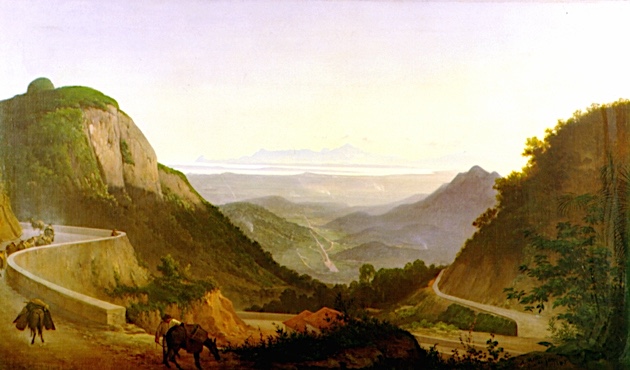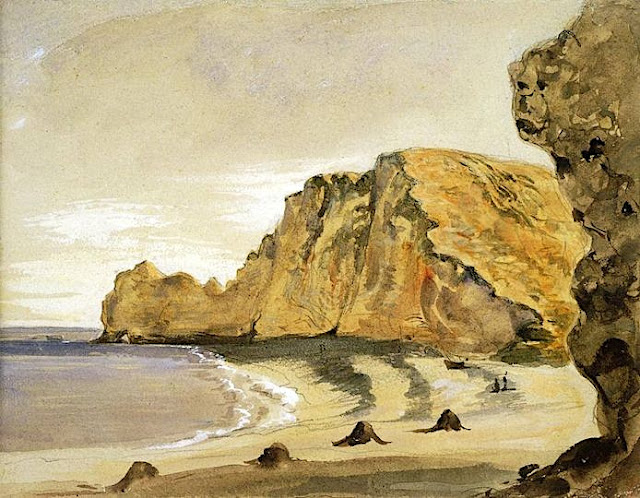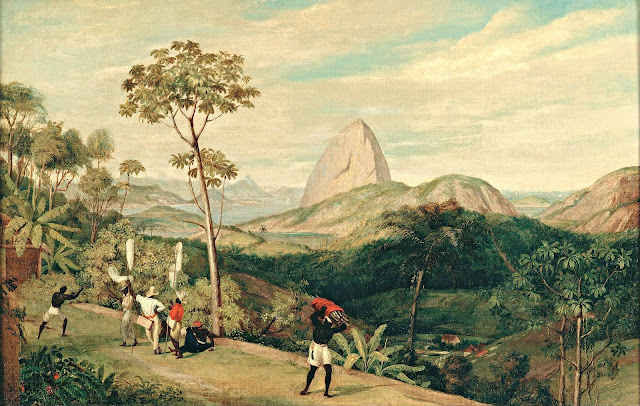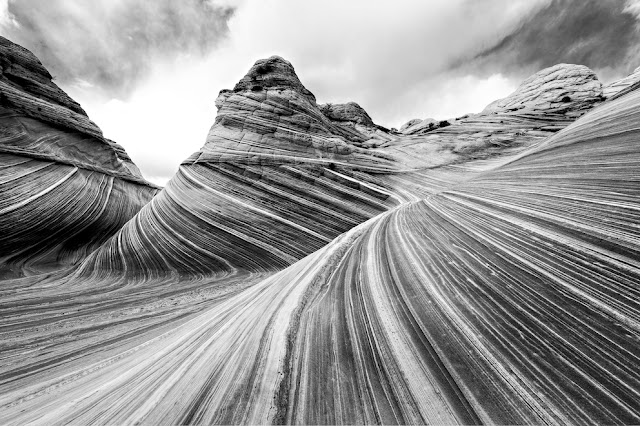EUGENE DELACROIX (1798-1863)
Les Falaises d'Etretat (70 à 90 m)
France (Normandie)
In Vue de la plage et des falaises d'Etretat, aquarelle sur traits à la mine de plomb, 15x19 cm, Musée Fabre, Montpellier
A propos de cette œuvreDelacroix découvrit les beautés de la côte normande grâce à ses nombreux passages chez son cousin Bataille à Valmont, près de Fécamp. "
Séjour de paix et d'oubli du monde entier", cette retraite offrait à l'artiste un lieu idéal pour se reposer de Paris et élaborer ses grandes commandes officielles. Au cours de cette villégiature, il eut à maintes occasions l’opportunité d'admirer le paysage des falaises d'Etretat ; sans doute séduit par cette âpre et grandiose architecture de craie, il devait en donner plusieurs études et aquarelles. Cette vue prise de la porte d'Amont, à marée basse, ne peut être datée avec certitude mais un passage du Journal de l’artiste du 18 octobre 1849 relate une excursion en mer au large de Fécamp et situe, si ce n'est la chronologie de cette œuvre, du moins l'état d'esprit et les sentiments de l'artiste devant ce paysage : «
Le sol sous cette arche étonnante, semblait sillonné par les roues des chars et semblait les ruines d'une ville antique. Ce sol est ce blanc calcaire dont les falaises sont entièrement faites. Il y a des parties sur les rocs qui sont d'un brun de terre d'ombre, des parties très vertes et quelques-unes ocreuses. » Explorant la décomposition chromatique du paysage, Delacroix donne ici une aquarelle où palpite la densité de l’air et de l’eau et, avec cette manière très libre d’un dessin pris sur le vif, il témoigne de sa sensibilité pour ces vues de la nature qui annoncent déjà la peinture impressionniste. Ami de l’artiste, le critique Théophile Sylvestre conseilla en 1874 à Alfred Bruyas l’acquisition de cette oeuvre qui lui inspira ces réflexions :
« Dans le ciel solitaire, d’une pureté absolue et d’une légèreté sans fonds, on entendrait non seulement l’aile d’une mouette mais le bourdonnement d’un insecte [...]. L’effusion lumineuse n’a même pas de soubresauts tout le long de cette falaise abrupte, dont la croûte terrestre et le gazon rôti semblent à la fois un chaume de cabane et une peau de bête fauve. »
Les falaises
Les Falaises d'Etretat sont constituées d'une stratigraphie complexe de craies du Turonien et du Coniacien. Certaines falaises atteignent 90 mètres. Etretat est surtout connue pour ses falaises de craie, dont trois arches naturelles et une formation pointue appelée L'Aiguille (l'Aiguille), qui s'élève à 70 m au-dessus de la mer et L'Arche. Une rivière souterraine, puis l'érosion marine ont formé une arche naturelle et une aiguille d'une hauteur estimée de 55 mètres à 70 mètres, relique de la falaise. Ses falaises de craie blanche et ses plages de galets grisâtres en ont fait un des lieux du tourisme international avec plus de trois millions de visiteurs par an1, exposé aux même risques que d'autres grands sites mondiaux, avec trois chutes mortelles en 2022. Le tourisme de masse dégradant le site. Des peintres comme Albert Marquet, Gustave Courbet, Eugène Boudin ou encore Claude Monet ont contribué alors à sa publicité, tout en en immortalisant la spécificité. Des écrivains normands comme Maupassant et Gustave Flaubert furent des fidèles du lieu. Maurice Leblanc, qui y vécut, contribua au mythe entourant le site entretenu dans une aventure d'Arsène Lupin intitulée L'Aiguille creuse(1909). Il les décrit en ces termes : « Un énorme gardon, haut de plus de quatre-vingts mètres, obélisque colossal, d'aplomb sur son socle de granit. » A son époque, le site attirait déjà de nombreux touristes parmi eu xdes "lupinophiles" admirateurs d'Arsène Lupin des étudiants américains venaient chercher la clé de la grotte, où le "gentleman cambrioleur" avait trouvé le trésor des rois de France.
Le peintre
Ferdinand Victor Eugène Delacroix était un artiste romantique français considéré dès le début de sa carrière comme le chef de file de l'école romantique française. L'utilisation par Delacroix de coups de pinceau expressifs et ses études sur les effets optiques de la couleur ont profondément façonné le travail des impressionnistes, alrors que sa passion pour l'exotisme a inspiré les artistes du mouvement symboliste. Fin lithographe, Delacroix a illustré diverses œuvres (William Shakespeare, Walter Scott et Goethe notamment).
Contrairement au perfectionnisme néoclassique de son principal rival Ingres, Delacroix s'est inspiré de l'art de Rubens et des peintres de la Renaissance vénitienne, en mettant l'accent sur la couleur et le mouvement plutôt que sur la clarté des contours et la forme soigneusement modelée. Le contenu dramatique et romantique caractérise les thèmes centraux de sa maturité et le conduit non pas vers les modèles classiques de l'art grec et romain, mais plutôt vers les voyages en Afrique du Nord à la recherche de l'exotisme. Ami et héritier spirituel de Théodore Géricault, Delacroix s'inspire également de Lord Byron, avec qui il partage une forte identification aux « forces du sublime », et aux actions de la nature, souvent violente.
Cependant, Delacroix n'était enclin ni à la sentimentalité ni à l'emphase, et son romantisme était celui d'un individualiste. Selon les mots de Baudelaire : « Delacroix était passionnément amoureux de la passion, mais froidement déterminé à exprimer sa passion le plus clairement possible ».
En 1832, Delacroix se rend en Espagne et en Afrique du Nord, dans le cadre d'une mission diplomatique au Maroc peu après la conquête de l'Algérie par la France. Il n'y est pas allé pour étudier l'art, mais pour échapper au parisianisme dans l'espoir d'approcher une culture plus primitive. Il a produit plus de 100 peintures et dessins de scènes tirées ou basées sur la vie des peuples d'Afrique du Nord, et a ajouté un nouveau chapitre très personnel à l'intérêt général porté alors à l'orientalisme. Delacroix était fasciné par les gens et les costumes, et le voyage allait éclairer le sujet d'un grand nombre de ses futurs tableaux. Il pensait que les Nord-Africains, dans leurs vêtements et leurs attitudes, fournissaient un équivalent visuel aux peuples de la Rome et de la Grèce classiques : « Les Grecs et les Romains sont ici à ma porte, chez les Arabes qui s'enveloppent dans une couverture blanche et regardent comme Caton ou Brutus..."
Il réussit à dessiner secrètement quelques femmes à Alger, comme dans le tableau Femmes d'Alger dans leur appartement (1834), mais il rencontra généralement des difficultés à trouver des femmes musulmanes prêtes à poser pour lui en raison des règles musulmanes exigeant que les femmes soient couvertes. La peinture des femmes juives d’Afrique du Nord, comme sujets du Mariage juif au Maroc (1837-1841), pose moins de problèmes.
À Tanger, Delacroix réalise de nombreux croquis des gens et de la ville, sujets sur lesquels il reviendra jusqu'à la fin de sa vie. Les animaux, incarnation de la passion romantique, ont été incorporés dans des peintures telles que Chevaux arabes se battant dans une écurie (1860), La Chasse au lion (dont il existe de nombreuses versions, peintes entre 1856 et 1861) et Arabe sellant son cheval (1855). .
_________________________________________
2024 - Wandering Vertexes ....
Gravir les montagnes en peinture
Un blog de Francis Rousseau
Falaise%20de%20Deippe%201882%20.jpg)


%20Titre%20:%20Les%20Drus,%20massif%20du%20Mont-Blanc%20Support%20:%20oil%20on%20panel%20Taille%20:%2061%20x%2050%20cm.%20(24%20x%2019.7%20in.).png)












